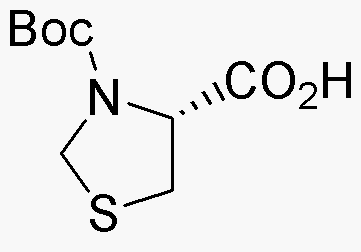Boc-L-thiaproline is widely utilized in research focused on:
- Peptide Synthesis: This compound serves as a valuable building block in the synthesis of peptides, particularly in the development of cyclic peptides that can enhance biological activity.
- Drug Development: It plays a crucial role in medicinal chemistry, where it is used to design and synthesize novel drugs, especially those targeting specific receptors or enzymes.
- Bioconjugation: Researchers leverage Boc-L-thiaproline for bioconjugation processes, allowing for the attachment of biomolecules to therapeutic agents, improving their efficacy and targeting capabilities.
- Protein Engineering: Its unique structure aids in the modification of proteins, enabling scientists to create proteins with enhanced stability and functionality for various applications in biotechnology.
- Research in Neuroscience: The compound is explored for its potential applications in neuroscience, particularly in studying the effects of modified peptides on neurological pathways and disorders.
Información general
Propiedades
Seguridad y normativas
Aplicaciones
Boc-L-thiaproline is widely utilized in research focused on:
- Peptide Synthesis: This compound serves as a valuable building block in the synthesis of peptides, particularly in the development of cyclic peptides that can enhance biological activity.
- Drug Development: It plays a crucial role in medicinal chemistry, where it is used to design and synthesize novel drugs, especially those targeting specific receptors or enzymes.
- Bioconjugation: Researchers leverage Boc-L-thiaproline for bioconjugation processes, allowing for the attachment of biomolecules to therapeutic agents, improving their efficacy and targeting capabilities.
- Protein Engineering: Its unique structure aids in the modification of proteins, enabling scientists to create proteins with enhanced stability and functionality for various applications in biotechnology.
- Research in Neuroscience: The compound is explored for its potential applications in neuroscience, particularly in studying the effects of modified peptides on neurological pathways and disorders.
Documentos
Hojas de datos de seguridad (HDS)
La SDS proporciona información de seguridad completa sobre la manipulación, el almacenamiento y la eliminación del producto.
Especificación del producto (PS)
La PS proporciona un desglose completo de las propiedades del producto, incluida la composición química, el estado físico, la pureza y los requisitos de almacenamiento. También detalla los rangos de calidad aceptables y las aplicaciones previstas del producto.
Certificados de análisis (COA)
Busque certificados de análisis (COA) ingresando el número de lote del producto. Los números de lote y de partida se pueden encontrar en la etiqueta de un producto después de las palabras "Lote" o "Lote".
Número de catálogo
Número de lote/lote
Certificados de origen (COO)
Este certificado de origen confirma el país en el que se fabricó el producto y también detalla los materiales y componentes utilizados en él y si se deriva de fuentes naturales, sintéticas u otras fuentes específicas. Este certificado puede ser necesario para cumplir con las normativas aduaneras, comerciales y regulatorias.
Número de catálogo
Número de lote/lote
Hojas de datos de seguridad (HDS)
La SDS proporciona información de seguridad completa sobre la manipulación, el almacenamiento y la eliminación del producto.
DownloadEspecificación del producto (PS)
La PS proporciona un desglose completo de las propiedades del producto, incluida la composición química, el estado físico, la pureza y los requisitos de almacenamiento. También detalla los rangos de calidad aceptables y las aplicaciones previstas del producto.
DownloadCertificados de análisis (COA)
Busque certificados de análisis (COA) ingresando el número de lote del producto. Los números de lote y de partida se pueden encontrar en la etiqueta de un producto después de las palabras "Lote" o "Lote".
Número de catálogo
Número de lote/lote
Certificados de origen (COO)
Este certificado de origen confirma el país en el que se fabricó el producto y también detalla los materiales y componentes utilizados en él y si se deriva de fuentes naturales, sintéticas u otras fuentes específicas. Este certificado puede ser necesario para cumplir con las normativas aduaneras, comerciales y regulatorias.


